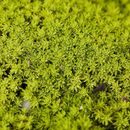Comments
provided by eFloras
Barbula unguiculata is common in eastern North America and Europe, and elsewhere in the North and South Temperate zones, but rare in the tropics and the Arctic, with, for instance, only two known sites in Mexico and a single one north of the Arctic tree line. The leaves are often blackened. Forms with strongly mucronate leaf apices have been referred to var. apiculata though modern authorities generally treat this as a form. Barbula indica is often confused with this species, but differs immediately in the leaves conduplicate but not contorted when dry, with plane or weakly recurved margins, and prorate abaxial surface of the costa. Barbula convoluta is similar but has plane margins, costa not excurrent as a mucro and seta yellow rather than reddish brown.
- license
- cc-by-nc-sa-3.0
- copyright
- Missouri Botanical Garden, 4344 Shaw Boulevard, St. Louis, MO, 63110 USA
Description
provided by eFloras
Plants small to large, slender to rather robust, 5–40 mm high, green to brownish green, in soft, loose tufts. Stems erect, usually irregularly branched, often radiculose at base. Leaves contorted or crisped when dry, erect-spreading when moist, ovate-lanceolate to narrow-ligulate, obtusely pointed to apiculate; margins entire, plane above, recurved in lower half; costa stout, shortly excurrent as a mucro; upper leaf cells quadrate to hexagonal, rather thin-walled, obscure, multi-papillose, with several, small, C-shaped papillae; basal cells differentiated, short-rectangular, somewhat thick-walled, smooth, rarely papillose, hyaline to green. Gemmae absent. Dioicous. Setae 10–15 mm long, reddish brown; capsules erect, cylindrical; peristome teeth filiform, twisted, densely papillose; opercula conic-rostrate, with an erect beak.
- license
- cc-by-nc-sa-3.0
- copyright
- Missouri Botanical Garden, 4344 Shaw Boulevard, St. Louis, MO, 63110 USA
Description
provided by eFloras
Stems 1-2 cm. Leaves firm when wet, long-ligulate to broadly lanceolate from an oblong base, 1-2.5 mm, base often oblong and widened, not strongly sheathing, margins recurved in the proximal 1/2-2/3, rarely to near apex or plane, apex broadly acute to rounded; costa excurrent as a short or long mucro, seldom muticous, abaxial costal surface with scattered solid papillae, hydroids present; distal laminal cells firm-walled, quadrate, 8-12 µm wide, 1:1, papillose. Specialized asexual reproduction absent. Perichaetial leaves weakly differentiated. Seta 1-2.5 cm. Theca 1-2.5 mm. Spores 8-11 µm.
- license
- cc-by-nc-sa-3.0
- copyright
- Missouri Botanical Garden, 4344 Shaw Boulevard, St. Louis, MO, 63110 USA
Distribution
provided by eFloras
Distribution: China, Japan, India, Russia, Europe, northern Africa, North and South America, and Australia.
- license
- cc-by-nc-sa-3.0
- copyright
- Missouri Botanical Garden, 4344 Shaw Boulevard, St. Louis, MO, 63110 USA
Habitat
provided by eFloras
Habitat: common on rocks, thin soil over rocks; also on forest ground and grassland.
- license
- cc-by-nc-sa-3.0
- copyright
- Missouri Botanical Garden, 4344 Shaw Boulevard, St. Louis, MO, 63110 USA
Synonym
provided by eFloras
Streblotrichum unguiculatum (Hedw.) Loeske, Stud. Morph. Syst. Laubm. 102. 1910. Tortula unguiculata (Hedw.) P. de Beauv., Prodr. Aethéogam. 93. 1805, hom. illeg.
Barbula ochracea Broth. ex Levier, Nuovo Giorn. Bot. Ital., n. ser. 13: 249. 1906. Type. China: Shaanxi (Schen-si), Kuan-tou-san, 13 X 1898, P. J. Giraldi s.n. (isotype H).
Barbula subunguiculata Schimp. ex Besch., Ann. Sci. Nat., Bot., sér. 7, 17: 337. 1893.
Barbula tokyoensis Besch., J. Bot. (Desvaux) 12: 296. 1898.
Barbula unguiculata var. trichostomifolia (C. Müll.) P.-C. Chen, Hedwigia 80: 217. 1941. Barbula trichostomifolia C. Müll., Nuovo Giorn. Bot. Ital., n. ser. 4: 256. 1897. Type. China: Shaanxi (Schen-si), Lao-y-san, P. J. Giraldi 1383 (isotype H).
Tortella himantina (Besch.) Broth., Nat. Pflanzenfam. I(3): 397. 1902. Barbula himantina Besch., Ann. Sci. Nat., Bot., sér. 7, 17: 337. 1893.
- license
- cc-by-nc-sa-3.0
- copyright
- Missouri Botanical Garden, 4344 Shaw Boulevard, St. Louis, MO, 63110 USA
Synonym
provided by eFloras
Barbula unguiculata var. apiculata (Hedwig) Bruch, Schimper & W. Gümbel
- license
- cc-by-nc-sa-3.0
- copyright
- Missouri Botanical Garden, 4344 Shaw Boulevard, St. Louis, MO, 63110 USA
Barbula unguiculata
provided by wikipedia EN
- license
- cc-by-sa-3.0
- copyright
- Wikipedia authors and editors
Barbula unguiculata: Brief Summary
provided by wikipedia EN
Barbula unguiculata is a species of moss belonging to the family Pottiaceae.
Barbula unguiculata is known to be able to use artificial light to grow in places which are otherwise devoid of natural light, such as Niagara Cave and Crystal Cave in Wisconsin.
- license
- cc-by-sa-3.0
- copyright
- Wikipedia authors and editors

